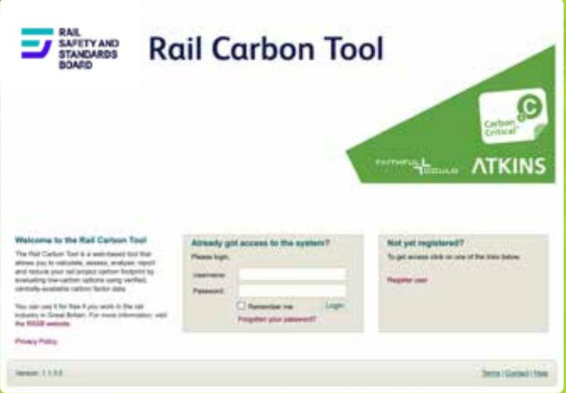RSSB’s Rail Carbon Tool enables the rail industry to calculate and analyse the carbon footprints of UK rail projects and activities, select low carbon solutions, and help reduce the industry’s carbon footprint.
Guidance for RSSB’s Rail Carbon Tool has been improved in ways that restrict some user choices. Although this might sound unhelpful, it is actually a very good idea both for individual projects and the rail industry to help increase accuracy and consistency across the whole rail sector.
Existing users of the Rail Carbon Tool may be familiar with the way the layout of its carbon assessment used to be left to the individual user and their own preferences. This meant that individual users could decide the scale and type of carbon assessment scopes to include in their use of the tool. If an individual user didn’t want or need to record, for example, transport, construction, whole life, or end of life impacts within the scope of their use, they didn’t have to.

This is all well and good for an early-stage tool, but it has very significant limitations for both carbon reduction and railway finance. It means that there are many inconsistencies in the ways different projects from different parts of the railway industry have used the tool previously. It is then impossible to capture all the carbon-reducing impacts the railway is actually implementing because only some are being recorded and very few are being shared. It also means that areas for carbon reduction that could, and should, be targeted for action are being needlessly ignored.
The overall effects of this are a reduced ability of managers to argue the business case for carbon reduction projects, and an unnecessary underestimation of the railway’s current and potential ability to deliver on the Net Zero carbon agenda. The guidance for using the tool has been improved so that the rail industry can increase its actions to reduce carbon emissions on projects.
Limiting tool choices increases railway performance
So, what are the recent changes to the guidance for using the tool, and how do they help individual projects and the railway overall?
First, standard project templates and project naming conventions promote a more consistent format for all assessments across the industry. This enables the development of a whole-industry perspective as well as allowing meaningful carbon comparisons to be made between different parts of the railway.
Second, and perhaps most importantly, projects will now confirm their carbon assessment scope based on their scale or type, rather than what they feel might be required or appropriate. This ensures that users of the Rail Carbon Tool consistently report carbon metrics across the industry and include whole life cycle impacts aligned to PAS 2080, the BSI developed standard for managing carbon in the built environment. Alignment to PAS 2080 is important because it is a global standard for managing infrastructure carbon and has been authored to meet World Trade Organization requirements.
There can be some welcome surprises in doing this. For instance, Amey used the Rail Carbon Tool in the Kentish Town Track Stabilisation project between December 2021 and January 2022. The tool was used in two ways: as an optioneering tool for the design phase and as a way of tracking carbon during the construction phase. This ensured the project was in line with PAS 2080 and Amey’s commitment to Net Zero by 2040.
The scope of the carbon assessment included the following components:
- Materials (embodied carbon)
- Materials (travel: gate to site)
- Waste (embodied carbon and travel)
- Plant & Equipment (fuel use onsite)
- Plant & Equipment (travel: depot to site)
- Employees (travel)
Amey used varying design and construction methodologies from the Rail Carbon Tool to achieve carbon reductions during each phase of the project. Overall, a total of 14 ‘carbon interventions’ were undertaken over the design and construction phases to reduce carbon. By including the above six components within the scope, the Kentish Town project reduced total project CO2e by 32.36% relative to the original design and construction methodology.
Carbon reductions can also be seen when looking at parts of the project. For instance, focusing on transport, they found that the transport of plant to and from the site accounted for 17% of total project CO2e. This could have been reduced to just 8% of total project CO2e, if all plant had been sourced within a 50km radius of the project. This shows that, even without highly complex technological changes, significant reductions in carbon can be made.
Finally, Network Rail security groups are now providing sight and access to project carbon data. Although this does add security requirements to provide key Network Rail contacts with visibility of relevant project assessments, it will better support carbon review, interpretation, and benchmarking across the industry. This helps optimise the benefits that individual projects and the rail industry can gain from the Rail Carbon Tool and drive a step change in carbon reduction throughout the rail industry.
RSSB training
Using RSSB’s Rail Carbon Tool effectively can really help organisations find ways to reduce carbon emissions during each phase of a project. RSSB offers a six-hour training course (split into two three-hour sessions within the same week) which has been attended by hundreds of delegates from companies across the UK rail industry. The main aim of the course is to provide delegates with the knowledge to use the tool aligned to the requirements of the guidance.
If you’re interested in training on how to use the Rail Carbon Tool to realise its carbon reduction and financial benefits, contact the Training team at [email protected] or (+44) 020 3142 5418.

